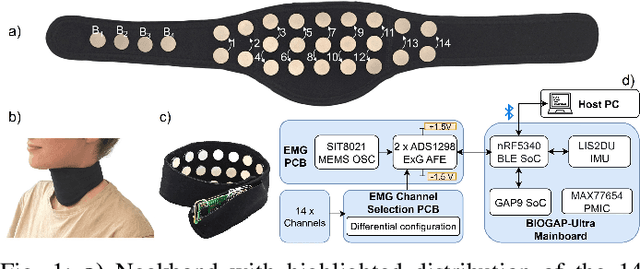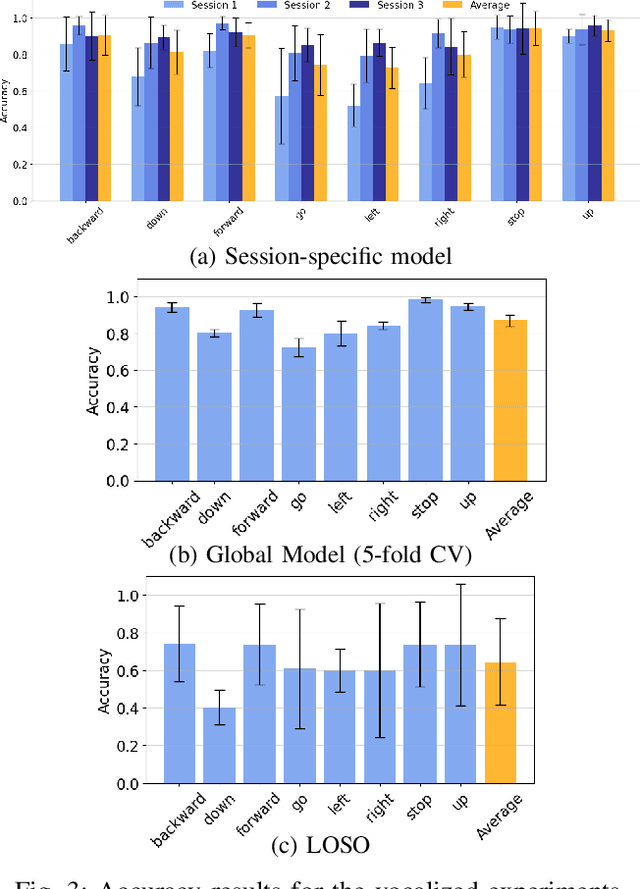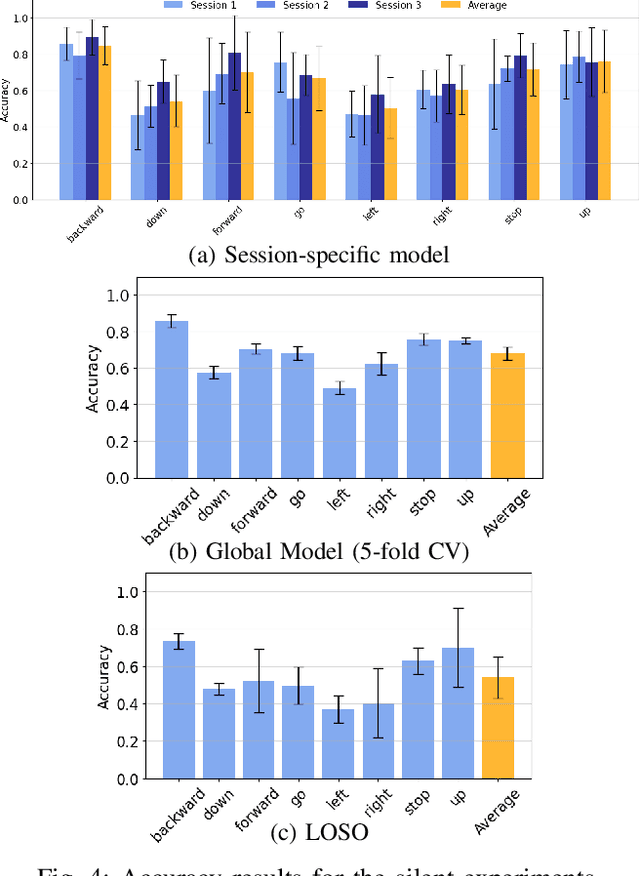speech
Papers and Code
Voice Evaluation of Reasoning Ability: Diagnosing the Modality-Induced Performance Gap
Sep 30, 2025We present Voice Evaluation of Reasoning Ability (VERA), a benchmark for evaluating reasoning ability in voice-interactive systems under real-time conversational constraints. VERA comprises 2,931 voice-native episodes derived from established text benchmarks and organized into five tracks (Math, Web, Science, Long-Context, Factual). Each item is adapted for speech interaction while preserving reasoning difficulty. VERA enables direct text-voice comparison within model families and supports analysis of how architectural choices affect reliability. We assess 12 contemporary voice systems alongside strong text baselines and observe large, consistent modality gaps: on competition mathematics a leading text model attains 74.8% accuracy while its voice counterpart reaches 6.1%; macro-averaged across tracks the best text models achieve 54.0% versus 11.3% for voice. Latency-accuracy analyses reveal a low-latency plateau, where fast voice systems cluster around ~10% accuracy, while approaching text performance requires sacrificing real-time interaction. Diagnostic experiments indicate that common mitigations are insufficient. Increasing "thinking time" yields negligible gains; a decoupled cascade that separates reasoning from narration improves accuracy but still falls well short of text and introduces characteristic grounding/consistency errors. Failure analyses further show distinct error signatures across native streaming, end-to-end, and cascade designs. VERA provides a reproducible testbed and targeted diagnostics for architectures that decouple thinking from speaking, offering a principled way to measure progress toward real-time voice assistants that are both fluent and reliably reasoned.
Comprehend and Talk: Text to Speech Synthesis via Dual Language Modeling
Sep 26, 2025Existing Large Language Model (LLM) based autoregressive (AR) text-to-speech (TTS) systems, while achieving state-of-the-art quality, still face critical challenges. The foundation of this LLM-based paradigm is the discretization of the continuous speech waveform into a sequence of discrete tokens by neural audio codec. However, single codebook modeling is well suited to text LLMs, but suffers from significant information loss; hierarchical acoustic tokens, typically generated via Residual Vector Quantization (RVQ), often lack explicit semantic structure, placing a heavy learning burden on the model. Furthermore, the autoregressive process is inherently susceptible to error accumulation, which can degrade generation stability. To address these limitations, we propose CaT-TTS, a novel framework for robust and semantically-grounded zero-shot synthesis. First, we introduce S3Codec, a split RVQ codec that injects explicit linguistic features into its primary codebook via semantic distillation from a state-of-the-art ASR model, providing a structured representation that simplifies the learning task. Second, we propose an ``Understand-then-Generate'' dual-Transformer architecture that decouples comprehension from rendering. An initial ``Understanding'' Transformer models the cross-modal relationship between text and the audio's semantic tokens to form a high-level utterance plan. A subsequent ``Generation'' Transformer then executes this plan, autoregressively synthesizing hierarchical acoustic tokens. Finally, to enhance generation stability, we introduce Masked Audio Parallel Inference (MAPI), a nearly parameter-free inference strategy that dynamically guides the decoding process to mitigate local errors.
Decoding Deception: Understanding Automatic Speech Recognition Vulnerabilities in Evasion and Poisoning Attacks
Sep 26, 2025Recent studies have demonstrated the vulnerability of Automatic Speech Recognition systems to adversarial examples, which can deceive these systems into misinterpreting input speech commands. While previous research has primarily focused on white-box attacks with constrained optimizations, and transferability based black-box attacks against commercial Automatic Speech Recognition devices, this paper explores cost efficient white-box attack and non transferability black-box adversarial attacks on Automatic Speech Recognition systems, drawing insights from approaches such as Fast Gradient Sign Method and Zeroth-Order Optimization. Further, the novelty of the paper includes how poisoning attack can degrade the performances of state-of-the-art models leading to misinterpretation of audio signals. Through experimentation and analysis, we illustrate how hybrid models can generate subtle yet impactful adversarial examples with very little perturbation having Signal Noise Ratio of 35dB that can be generated within a minute. These vulnerabilities of state-of-the-art open source model have practical security implications, and emphasize the need for adversarial security.
Leveraging Large Language Models for Robot-Assisted Learning of Morphological Structures in Preschool Children with Language Vulnerabilities
Sep 26, 2025Preschool children with language vulnerabilities -- such as developmental language disorders or immigration related language challenges -- often require support to strengthen their expressive language skills. Based on the principle of implicit learning, speech-language therapists (SLTs) typically embed target morphological structures (e.g., third person -s) into everyday interactions or game-based learning activities. Educators are recommended by SLTs to do the same. This approach demands precise linguistic knowledge and real-time production of various morphological forms (e.g., "Daddy wears these when he drives to work"). The task becomes even more demanding when educators or parent also must keep children engaged and manage turn-taking in a game-based activity. In the TalBot project our multiprofessional team have developed an application in which the Furhat conversational robot plays the word retrieval game "Alias" with children to improve language skills. Our application currently employs a large language model (LLM) to manage gameplay, dialogue, affective responses, and turn-taking. Our next step is to further leverage the capacity of LLMs so the robot can generate and deliver specific morphological targets during the game. We hypothesize that a robot could outperform humans at this task. Novel aspects of this approach are that the robot could ultimately serve as a model and tutor for both children and professionals and that using LLM capabilities in this context would support basic communication needs for children with language vulnerabilities. Our long-term goal is to create a robust LLM-based Robot-Assisted Language Learning intervention capable of teaching a variety of morphological structures across different languages.
* 12 pages, 2 figures, Preprint of: Sundstedt, S., Wingren, M., H\"agglund, S. & Ventus, D. (2025). Leveraging Large Language Models for Robot-Assisted Learning of Morphological Structures in Preschool Children with Language Vulnerabilities. In: Stephanidis, C., Antona, M., Ntoa, S. & Salvendy, G. (eds.), Communications in Computer and Information Science, vol. 2523, pp. 415-425. Springer
Speaker Anonymisation for Speech-based Suicide Risk Detection
Sep 26, 2025Adolescent suicide is a critical global health issue, and speech provides a cost-effective modality for automatic suicide risk detection. Given the vulnerable population, protecting speaker identity is particularly important, as speech itself can reveal personally identifiable information if the data is leaked or maliciously exploited. This work presents the first systematic study of speaker anonymisation for speech-based suicide risk detection. A broad range of anonymisation methods are investigated, including techniques based on traditional signal processing, neural voice conversion, and speech synthesis. A comprehensive evaluation framework is built to assess the trade-off between protecting speaker identity and preserving information essential for suicide risk detection. Results show that combining anonymisation methods that retain complementary information yields detection performance comparable to that of original speech, while achieving protection of speaker identity for vulnerable populations.
Towards Cross-Task Suicide Risk Detection via Speech LLM
Sep 26, 2025Suicide risk among adolescents remains a critical public health concern, and speech provides a non-invasive and scalable approach for its detection. Existing approaches, however, typically focus on one single speech assessment task at a time. This paper, for the first time, investigates cross-task approaches that unify diverse speech suicide risk assessment tasks within a single model. Specifically, we leverage a speech large language model as the backbone and incorporate a mixture of DoRA experts (MoDE) approach to capture complementary cues across diverse assessments dynamically. The proposed approach was tested on 1,223 participants across ten spontaneous speech tasks. Results demonstrate that MoDE not only achieves higher detection accuracy than both single-task specialised models and conventional joint-tuning approaches, but also provides better confidence calibration, which is especially important for medical detection tasks.
A Parallel Ultra-Low Power Silent Speech Interface based on a Wearable, Fully-dry EMG Neckband
Sep 26, 2025



We present a wearable, fully-dry, and ultra-low power EMG system for silent speech recognition, integrated into a textile neckband to enable comfortable, non-intrusive use. The system features 14 fully-differential EMG channels and is based on the BioGAP-Ultra platform for ultra-low power (22 mW) biosignal acquisition and wireless transmission. We evaluate its performance on eight speech commands under both vocalized and silent articulation, achieving average classification accuracies of 87$\pm$3% and 68$\pm$3% respectively, with a 5-fold CV approach. To mimic everyday-life conditions, we introduce session-to-session variability by repositioning the neckband between sessions, achieving leave-one-session-out accuracies of 64$\pm$18% and 54$\pm$7% for the vocalized and silent experiments, respectively. These results highlight the robustness of the proposed approach and the promise of energy-efficient silent-speech decoding.
Speak Your Mind: The Speech Continuation Task as a Probe of Voice-Based Model Bias
Sep 26, 2025Speech Continuation (SC) is the task of generating a coherent extension of a spoken prompt while preserving both semantic context and speaker identity. Because SC is constrained to a single audio stream, it offers a more direct setting for probing biases in speech foundation models than dialogue does. In this work we present the first systematic evaluation of bias in SC, investigating how gender and phonation type (breathy, creaky, end-creak) affect continuation behaviour. We evaluate three recent models: SpiritLM (base and expressive), VAE-GSLM, and SpeechGPT across speaker similarity, voice quality preservation, and text-based bias metrics. Results show that while both speaker similarity and coherence remain a challenge, textual evaluations reveal significant model and gender interactions: once coherence is sufficiently high (for VAE-GSLM), gender effects emerge on text-metrics such as agency and sentence polarity. In addition, continuations revert toward modal phonation more strongly for female prompts than for male ones, revealing a systematic voice-quality bias. These findings highlight SC as a controlled probe of socially relevant representational biases in speech foundation models, and suggest that it will become an increasingly informative diagnostic as continuation quality improves.
AUV: Teaching Audio Universal Vector Quantization with Single Nested Codebook
Sep 26, 2025We propose AUV, a unified neural audio codec with a single codebook, which enables a favourable reconstruction of speech and further extends to general audio, including vocal, music, and sound. AUV is capable of tackling any 16 kHz mixed-domain audio segment at bit rates around 700 bps. To accomplish this, we guide the matryoshka codebook with nested domain-specific partitions, assigned with corresponding teacher models to perform distillation, all in a single-stage training. A conformer-style encoder-decoder architecture with STFT features as audio representation is employed, yielding better audio quality. Comprehensive evaluations demonstrate that AUV exhibits comparable audio reconstruction ability to state-of-the-art domain-specific single-layer quantizer codecs, showcasing the potential of audio universal vector quantization with a single codebook. The pre-trained model and demo samples are available at https://swivid.github.io/AUV/.
Lightweight Structured Multimodal Reasoning for Clinical Scene Understanding in Robotics
Sep 26, 2025Healthcare robotics requires robust multimodal perception and reasoning to ensure safety in dynamic clinical environments. Current Vision-Language Models (VLMs) demonstrate strong general-purpose capabilities but remain limited in temporal reasoning, uncertainty estimation, and structured outputs needed for robotic planning. We present a lightweight agentic multimodal framework for video-based scene understanding. Combining the Qwen2.5-VL-3B-Instruct model with a SmolAgent-based orchestration layer, it supports chain-of-thought reasoning, speech-vision fusion, and dynamic tool invocation. The framework generates structured scene graphs and leverages a hybrid retrieval module for interpretable and adaptive reasoning. Evaluations on the Video-MME benchmark and a custom clinical dataset show competitive accuracy and improved robustness compared to state-of-the-art VLMs, demonstrating its potential for applications in robot-assisted surgery, patient monitoring, and decision support.
 Add to Chrome
Add to Chrome Add to Firefox
Add to Firefox Add to Edge
Add to Edge